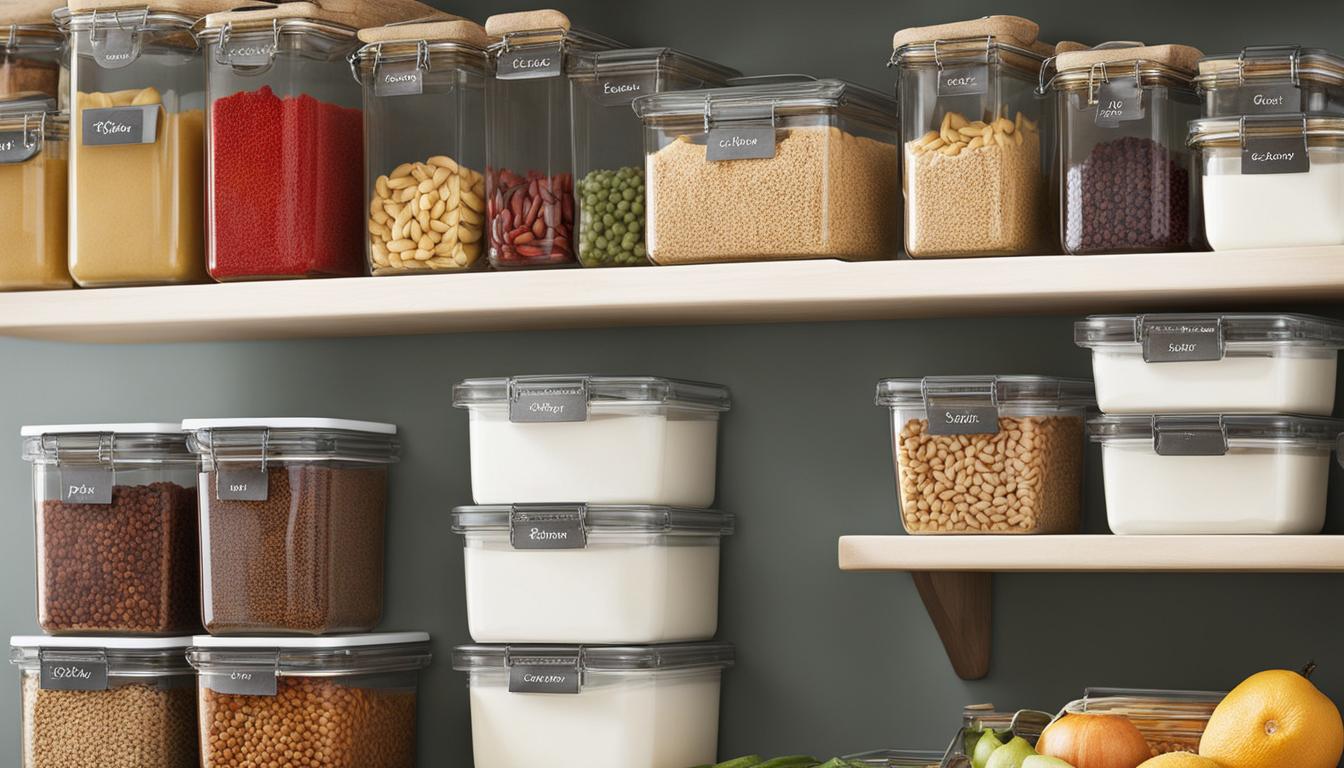
A mother and her children are gathered around a colorful fruit bowl, selecting their favorite fruits to snack on. The table is also filled with dishes of vibrant vegetables, such as sliced peppers and carrot sticks. The family looks happy and content as they make healthy choices together. A light-filled window in the background suggests the warmth and freshness of a new year.
Key Takeaways:
- Set family goals for healthier eating habits
- Involve each family member in making healthier choices
- Create a collaborative family meal plan
- Incorporate whole foods into your family's diet
- Encourage children to participate in meal preparation
Embracing Family Goals for Healthier Eating Habits
When it comes to establishing healthier eating habits, setting family goals is key. By working together as a unit, families can create a supportive environment that promotes nutritious choices and fosters a sense of collective responsibility. Involving each family member in the process not only empowers them to make healthier choices but also strengthens family bonds.
Involving Each Family Member in Healthier Choices
When it comes to healthier eating habits, it's crucial to involve each family member in the decision-making process. By allowing children and partners to participate in discussions and express their preferences, it promotes a sense of ownership and empowers them to make informed choices. Encourage open communication and consider everyone's input when planning meals and snacks. This collaborative approach ensures that everyone's needs and preferences are taken into account, making it more likely for the family to stick to their goals.
Creating a Collaborative Family Meal Plan
One effective way to create healthier eating habits as a family is by implementing a collaborative meal plan. Sit down together and brainstorm meal ideas, taking into consideration each family member's food preferences and dietary needs. Assign different meal responsibilities to family members, such as grocery shopping, meal preparation, and clean-up. By involving everyone in the process, it not only lightens the workload but also instills a sense of ownership and pride in the meals served. Additionally, a collaborative meal plan ensures that healthier choices are readily available and reduces the reliance on convenience foods.
By embracing family goals for healthier eating habits and involving each family member in making healthier choices, families can create a collaborative meal plan that promotes shared responsibility and fosters a healthier lifestyle. In the next section, we will explore the significance of incorporating whole foods into the family's diet and provide creative ideas to include fruits, vegetables, whole grains, and fiber-rich foods in daily meals.
The Significance of Whole Foods in Your Family's Diet
When it comes to achieving a healthy eating New Year resolution for your family, incorporating whole foods into your diet is key. Whole foods are minimally processed and retain their natural nutrients, making them essential for providing your family with the necessary vitamins and minerals. By prioritizing whole foods in your family's diet, you can enhance their overall well-being and support their long-term health.
Incorporating Fruits and Veggies into Daily Meals
One of the easiest ways to incorporate whole foods into your family's diet is by increasing the consumption of fruits and vegetables. These nutrient-rich foods provide a range of vitamins, minerals, and antioxidants that support optimal health. To make it fun and engaging for your family, try creating colorful fruit and vegetable platters, blending them into smoothies, or adding them to your favorite recipes.
Here are some creative ideas to include fruits and veggies into your family's daily meals:
- Top your morning cereal or oatmeal with fresh berries or sliced bananas.
- Make homemade fruit popsicles using pureed fruit and yogurt.
- Add spinach or kale to your family's favorite pasta sauce or casserole.
- Create a rainbow salad with assorted vegetables and a tangy vinaigrette dressing.
The Benefits of Whole Grains and Fiber-Rich Foods
Whole grains and fiber-rich foods are important components of a healthy diet. They provide sustained energy, promote healthy digestion, and help reduce the risk of chronic diseases. By including whole grains in your family's meals, you can add essential nutrients like fiber, vitamins, and minerals into their diet.
Here are some ways to incorporate whole grains and fiber-rich foods into your family's meals:
- Switch to whole wheat bread, pasta, and rice for added fiber.
- Replace refined grains with whole grain cereals or oats for breakfast.
- Add quinoa or brown rice to your family's stir-fries or salads.
- Snack on air-popped popcorn or whole grain crackers.
By prioritizing whole foods, such as fruits, veggies, whole grains, and fiber-rich foods, in your family's diet, you can provide the essential nutrients they need for optimal health. Get creative with your meals and enjoy the benefits of a wholesome and nourishing diet!
Interactive Meal Planning with Children
Involving children in meal planning and preparation can be a fun and educational experience for the whole family. Not only does it teach kids valuable cooking skills, but it also encourages them to make healthier food choices. By including children in the meal planning process, parents can foster their interest in nutrition and develop lifelong healthy eating habits. Here are some tips for interactive meal planning with children:
Encouraging Kids to Participate in Meal Preparation
Engaging children in meal preparation can help them feel a sense of ownership and pride in what they eat. Here are a few ways to get kids involved:
- Let them choose a recipe: Encourage children to pick a recipe they would like to try. This helps them feel invested in the meal and more likely to enjoy it.
- Assign age-appropriate tasks: Give kids specific tasks according to their age and abilities. Younger children can wash vegetables or mix ingredients, while older children can help chop vegetables or assist with cooking.
- Make it fun: Turn meal preparation into a game or challenge. For example, see who can peel carrots the fastest or create a funny face with fruits and vegetables on their plates.
By involving children in meal preparation, parents can build their confidence in the kitchen and instill a sense of responsibility for their own health.
Exploring Healthy and Kid-Approved Recipes
Introducing children to healthy and delicious recipes is key to fostering their love for nutritious food. Here are a few kid-approved recipes that are both tasty and nutritious:
- Homemade Veggie Pizza: Let children choose their favorite vegetables to top the pizza. They can help spread the sauce, sprinkle cheese, and arrange the vegetables.
- Fruit and Yogurt Parfait: Layer yogurt, fresh fruits, and granola in a glass to create a colorful and nutritious parfait. Children can assemble their own parfaits and get creative with different fruit combinations.
- Banana Oat Pancakes: These pancakes are made with mashed bananas and oats, making them a healthier alternative to traditional pancakes. Children can help mix the batter and flip the pancakes.
Encouraging children to try new recipes and flavors can expand their palate and make eating healthy more enjoyable.
FAQ: Achieve Your Family's Healthy Eating New Year Resolution
To involve each family member in making healthier choices, you can have open discussions about the importance of healthy eating and the benefits it offers. Encourage everyone to share their preferences and opinions on meals and snacks. Get input from each family member when creating the family's meal plan and grocery list. By involving everyone, you create a sense of ownership and collaboration in making healthier choices.
To create a collaborative family meal plan, gather input from each family member on their favorite foods and meals. Encourage everyone to contribute ideas for new recipes or variations of family favorites. Remember to consider each person's dietary needs and preferences. By involving your family in the meal planning process, you can ensure that everyone's preferences are considered, making it easier to stick to the plan.
To incorporate fruits and vegetables into your daily meals, try adding them to dishes like salads, stir-fries, or smoothies. You can also serve them as snacks or incorporate them into your favorite recipes. Get creative in finding new ways to enjoy fruits and vegetables. For example, you can make fruit kabobs or veggie-packed pasta dishes. By making fruits and vegetables a regular part of your meals, you'll increase your family's intake of essential vitamins and minerals.
Whole grains and fiber-rich foods offer numerous benefits for your family's health. They provide essential nutrients, such as vitamins, minerals, and antioxidants. They also contribute to improved digestion and bowel regularity. Whole grains and fiber-rich foods can help reduce the risk of chronic diseases like heart disease, diabetes, and certain cancers. Some examples of whole grains and fiber-rich foods include whole wheat bread, brown rice, oats, beans, and lentils.
To encourage your kids to participate in meal preparation, make it fun and engaging. Give them age-appropriate tasks, such as washing fruits and vegetables, stirring ingredients, or setting the table. You can also involve them in choosing recipes and going grocery shopping. By giving them a sense of responsibility and involving them in the process, they'll be more likely to develop an interest in making healthy food choices.
Absolutely! Here are some healthy and kid-approved recipes that the whole family can enjoy: - Veggie-packed Mini Frittatas - Chicken and Vegetable Skewers - Whole Wheat Pizza with Veggie Toppings - Homemade Granola Bars - Banana-Oat Pancakes These recipes are not only nutritious but also delicious. They're designed to appeal to kids' tastes while providing essential nutrients.
To make healthier snack choices accessible, stock up on nutritious options and have them readily available at home. Keep a bowl of fresh fruits on the countertop or pre-cut vegetables in the refrigerator. Replace sugary snacks with options like nuts, whole-grain crackers, or yogurt. By having these healthier options easily accessible, you and your family will be more likely to choose them over less nutritious alternatives.
Transitioning to healthier eating routines gradually can be more sustainable and manageable. Start by making small changes, such as swapping white bread for whole wheat or reducing sugary drinks. Gradually increase the variety of fruits and vegetables in your meals and experiment with new recipes. Allow yourself and your family time to adjust to these changes and be open to trying new foods. By taking it one step at a time, you can create lasting healthier eating habits.
Fostering a positive mindset is essential for maintaining dietary resolutions. Practice self-belief and celebrate small victories along the way. Surround yourself with positive influences, whether it's supportive friends and family or inspirational stories and quotes. Set realistic expectations and be kind to yourself if you face challenges or setbacks. By maintaining a positive mindset, you'll find the motivation and resilience to stay on track with your healthy eating goals.
Incorporating meal prepping into a busy schedule is possible with some planning. Set aside time on weekends to plan your meals and prep ingredients. Utilize time-saving techniques like batch cooking or doubling the recipe to have leftovers for the next day. Prepare grab-and-go options like overnight oats or pre-portioned salads. By dedicating time to meal prepping, you'll save time during the week and have nutritious meals readily available.
To create a supportive home environment, start by organizing your pantry to make healthy choices more visible and accessible. Remove unhealthy temptations by avoiding junk food purchases. Instead, stock up on nutritious alternatives. Make healthy snacks like cut-up fruits and vegetables the default option. Create a family culture that values and prioritizes healthy eating. By setting up your home environment to support healthy choices, you and your family are more likely to make them consistently.
Making healthy eating fun and engaging for kids can pique their interest. Involve them in grocery shopping and let them choose fruits and vegetables they want to try. Get creative with food presentation by making colorful and visually appealing meals. Use cookie cutters to shape fruits and vegetables into fun shapes. Encourage them to help in the kitchen with age-appropriate tasks. By making healthy eating enjoyable, you'll foster a positive relationship with food in your children.
Prioritizing mental health is crucial for your family's overall wellness. Practice gratitude as a family by sharing things you're grateful for every day. Recognize each family member's strengths and celebrate them. Limit screen time by setting boundaries and encouraging other activities like exercise or reading. Foster open communication within the family, ensuring that everyone feels heard and supported. By addressing mental health as a family, you create a nurturing environment for everyone's well-being.
Finding community support can be beneficial in maintaining healthy eating habits. Consider signing up for a healthy eating email series that offers ongoing support, tips, and resources. Engage with parenting and health newsletters to stay inspired and informed. Join online communities or forums focused on healthy eating, where you can connect with like-minded individuals and share experiences. By being part of a community that shares similar goals, you'll find encouragement and motivation along your journey.
Strategic Grocery Shopping for Success
Grocery shopping plays a crucial role in supporting your family's healthy eating goals. By adopting a strategic approach, you can ensure that your pantry is stocked with core healthy items and that healthier snack choices are readily available. Here are some tips to help you make the most out of your grocery shopping trips:
Stocking Up on Core Healthy Items
When creating your shopping list, prioritize core healthy items that form the foundation of nutritious meals. These include:
- Fresh produce: Fill your cart with a variety of fruits and vegetables, opting for seasonal options whenever possible. These nutrient-dense foods are packed with vitamins, minerals, and fiber that support overall health.
- Lean proteins: Choose lean sources of protein such as skinless poultry, fish, tofu, or legumes. These options provide essential amino acids and are lower in saturated fat compared to fatty cuts of meat.
- Whole grains: Opt for whole grain bread, pasta, and cereal to increase your family's fiber intake. These options are rich in nutrients and can help promote heart health.
- Healthy fats: Incorporate sources of healthy fats like nuts, seeds, avocados, and olive oil. These fats are essential for brain function and provide a feeling of satiety.
By filling your cart with these core healthy items, you'll have the foundation for creating balanced and nutritious meals for your family.
Making Healthier Snack Choices Accessible
In addition to stocking up on core healthy items, it's important to make healthier snack choices easily accessible. This can help prevent reaching for unhealthy options when hunger strikes. Consider the following tips:
- Prep snack-sized portions: Wash, cut, and portion fruits and vegetables ahead of time, storing them in clear containers in your refrigerator. This makes it convenient for your family to grab a healthy snack when hunger strikes.
- Keep it visible: Place healthier snack choices like nuts, seeds, and whole grain crackers in clear containers or bowls on your kitchen counter or in your pantry. This visual reminder makes it more likely that these options will be chosen over less nutritious alternatives.
- Try healthier alternatives: Explore healthier snack options that provide the satisfaction of traditional treats without sacrificing nutrition. Consider air-popped popcorn, homemade energy balls, or Greek yogurt with fresh berries as nutritious alternatives to processed snacks.
By implementing these strategies, you can ensure that your family has easy access to healthier snack choices, making it easier for everyone to make nutritious choices throughout the day.

A family standing in front of a grocery store with shopping carts, surrounded by healthy food options and signs promoting nutrition and wellness.
Choose the placement of the image so that it is visually appealing and relevant to the topic of the blog post, but it should only be in the center, not left and right, but in the center.
Continue to section 6: Setting Realistic and Achievable Dietary Goals
Setting Realistic and Achievable Dietary Goals
When it comes to improving your family's eating habits, setting realistic and achievable dietary goals is key. By establishing goals that are attainable, you can create a positive and sustainable change in your family's eating routines.
Starting Small with Manageable Changes
Starting small and making manageable changes is a great way to kickstart your journey toward healthier eating. Instead of completely overhauling your family's diet overnight, focus on making gradual improvements. For example, you can begin by incorporating more fruits and vegetables into your meals or reducing the consumption of sugary snacks.
This approach allows your family to adjust gradually and helps everyone develop healthier habits without feeling overwhelmed. By taking small steps, you can build confidence and increase the likelihood of long-term success.
Transitioning to Healthier Eating Routines Gradually
Transitioning to healthier eating routines gradually is essential for lasting change. Instead of implementing strict diets or drastic restrictions, encourage your family to adopt healthier choices over time.
One effective strategy is to introduce new foods or recipes slowly, allowing your family to explore different flavors and textures at their own pace. You can also involve your children in meal planning or grocery shopping to make them more invested in the process.
Remember, healthy eating is not about deprivation or perfection. It's about making sustainable changes that are enjoyable and manageable for everyone involved. Transitioning gradually ensures that your family can adapt to new eating routines without feeling deprived or overwhelmed.
The Role of Self-Belief in Maintaining Dietary Resolutions
When it comes to maintaining dietary resolutions, self-belief plays a crucial role. It's natural to face challenges and setbacks along the way, but with a positive mindset and unwavering belief in oneself, sustainable change is possible.
Fostering a Positive Mindset for Sustainable Change
A positive mindset is essential for overcoming obstacles and staying committed to dietary resolutions. Cultivating a positive mindset involves harnessing the power of positive thinking and reframing negative thoughts. Here are some practical strategies and techniques to foster a positive mindset:
- Gratitude Practice: Start each day by expressing gratitude for the opportunity to make healthier choices and nourish the body. Keep a gratitude journal or simply take a moment to reflect on the things you are grateful for.
- Affirmations: Affirmations are positive statements that help rewire the subconscious mind. Repeat empowering affirmations related to your dietary goals, such as "I am capable of making healthy choices" or "I have the power to transform my eating habits."
- Visualization: Visualize yourself successfully achieving your dietary resolutions. Picture yourself making nutritious meals, enjoying physical activities, and feeling vibrant and energized.
- Celebrate Small Wins: Acknowledge and celebrate each small accomplishment along the way. Recognize the progress you've made and the positive changes you've implemented in your lifestyle.
- Surround Yourself with Support: Seek out individuals who support your goals and share a similar mindset. Surrounding yourself with a positive and supportive community can provide encouragement and accountability.
Remember, maintaining dietary resolutions is a journey that requires dedication, patience, and self-belief. Embrace the power of a positive mindset, and let it guide you towards lasting and sustainable change.
Effective Time Management for Family Meals
When it comes to preparing and enjoying family meals, effective time management is crucial. With busy schedules and competing priorities, finding the time to plan, cook, and sit down for a meal together can be a challenge. However, with a bit of strategic planning and organization, it is possible to make family meals a regular part of your routine.

Photo by Artur Rutkowski on Unsplash
Meal Prepping to Accommodate Busy Schedules
One of the most effective strategies for managing time when it comes to family meals is meal prepping. By dedicating a few hours each week to planning and preparing meals in advance, you can save significant time during busy weekdays.
Here are some tips for meal prepping to accommodate busy schedules:
- Create a weekly meal plan and grocery list to ensure you have all the necessary ingredients on hand.
- Carve out a specific time each week to do the meal preparation, such as Sunday afternoon or Saturday morning.
- Cook large batches of staple foods like grains, proteins, and vegetables that can be used in multiple meals throughout the week.
- Invest in proper storage containers to keep prepped ingredients and meals fresh.
- Label and organize your prepped ingredients in the refrigerator and freezer, making it easy to assemble meals quickly.
By meal prepping, you can significantly reduce the time spent on daily meal preparation, allowing you to spend more quality time with your family.
Utilizing Weekends for Meal Planning and Prep
Another effective time management strategy for family meals is utilizing weekends for meal planning and prep. Weekends are often less hectic compared to weekdays, providing an opportunity to plan and prepare meals for the upcoming week.
Here's how you can make the most of your weekends for meal planning and prep:
- Set aside dedicated time on the weekend to sit down and plan your family's meals for the week ahead.
- Involve your family in the meal planning process, allowing everyone to contribute their preferences and ideas.
- Create a list of ingredients you will need for the planned meals and go grocery shopping over the weekend to ensure you have everything you need.
- Spend a portion of your weekend prepping ingredients, such as washing and chopping vegetables or marinating proteins.
- Cook any dishes that can be prepared in advance, such as casseroles or soups, and store them in the refrigerator or freezer for quick and easy reheating during the week.
By dedicating time on weekends for meal planning and prep, you can set yourself up for a stress-free week of family meals.
Creating a Supportive Home Environment
To achieve and maintain healthy eating habits, it is essential to create a supportive home environment that promotes good choices. By organizing your pantry and effectively limiting temptation, you can ensure that your family has easy access to nutritious options and avoids unhealthy temptations.

Show an organized pantry filled with healthy food options. Display a variety of labeled containers such as glass jars, plastic bin containers, and baskets that hold whole grains, nuts, seeds, beans, and dried fruits. There should be plenty of space for fresh fruits and vegetables in a designated area. Showcase a clear and uncluttered space that encourages healthy eating habits. Extra points for displaying natural cleaning products on the shelves or a compost bin nearb.
Organizing the Pantry to Encourage Healthy Choices
Organizing your pantry is a crucial step in making healthy choices more accessible and visible. By implementing a system that prioritizes nutritious foods, you can streamline meal preparation and encourage your family to reach for wholesome options.
Here are some helpful tips to organize your pantry:
- Group similar items together. Arrange your pantry shelves to categorize foods like grains, canned goods, spices, and snacks. This makes it easier to find what you need without any confusion.
- Place healthy options in plain sight. Move items like whole grains, nuts, seeds, and dried fruits to eye-level shelves. This will make them the first things your family sees when they open the pantry, helping to influence their food choices.
- Use clear containers. Invest in clear, airtight containers to store items like grains, cereals, and snacks. Not only does this preserve freshness, but it also allows you to see what's inside at a glance and avoid any unpleasant surprises.
- Label everything. Labeling shelves and containers will help you and your family quickly identify where things belong, making it easier to maintain an organized pantry over time.
Limiting Temptation by Avoiding Junk Food Purchases
One of the most effective ways to foster a supportive home environment is by limiting temptation through mindful grocery shopping. By avoiding unnecessary junk food purchases and instead focusing on nutritious alternatives, you can create a positive food environment that supports your family's health goals.
Here are some strategies to help you make healthier choices at the grocery store:
- Create a shopping list and stick to it. Plan your meals in advance and write down the ingredients you need. This will help you stay focused and avoid impulsive purchases.
- Shop the perimeter of the store. The outer aisles typically contain fresh produce, dairy, and lean proteins. Fill your cart with these healthier options before venturing into the processed food aisles.
- Read food labels. Pay attention to the nutritional information and ingredients list on packaged foods. Choose items that are lower in added sugars, unhealthy fats, and sodium.
- Stock up on nutritious snacks. Instead of reaching for chips or cookies, choose healthier alternatives like fresh fruit, yogurt, or nuts. Having these options readily available at home will make it easier to resist unhealthy temptations.
Creating a supportive home environment is key to ensuring the success of your family's healthy eating journey. By organizing your pantry and avoiding junk food purchases, you can provide a nourishing space that promotes healthy choices. Remember, small changes can add up to make a big difference!
Instilling Lifelong Healthy Habits in Children
When it comes to healthy eating, instilling lifelong habits in children is essential. By starting early and making it fun and engaging, you can set your kids up for a lifetime of nutritious choices.

Photo by Jason Briscoe on Unsplash
Making Healthy Eating Fun and Engaging for Kids
One of the best ways to encourage healthy eating in children is to make it exciting and enjoyable. Get your kids involved in the process by taking them grocery shopping with you. Teach them about different fruits, vegetables, and whole foods, and let them pick out their favorites. This not only empowers them to make their own choices but also educates them about the importance of nutritious foods.
Cooking and meal preparation can also be a fun activity for kids. Allow them to assist you in the kitchen, whether it's mixing ingredients, chopping vegetables, or setting the table. This hands-on experience not only teaches them valuable skills but also makes them feel proud of their contributions to the family meals.
Another way to make healthy eating engaging is to introduce themed or colorful meals. Create a "rainbow plate" by incorporating a variety of colorful fruits and vegetables. Make it a challenge for your kids to try new foods and earn rewards for their adventurous eating. By making healthy eating a game, you're more likely to spark their interest and enthusiasm.
Empowering Kids to Set and Achieve Personal Health Goals
Empowering children to set and achieve their personal health goals is essential for their long-term well-being. Encourage them to think about what they would like to achieve, whether it's eating a certain number of servings of fruits and vegetables each day or trying a new healthy recipe each week.
Help your kids break down their goals into smaller, manageable actions. For example, if their goal is to eat more fruits and vegetables, they can start by adding an extra serving to their meals or replacing sugary snacks with fruit. Celebrate their progress and encourage them to continue making healthy choices.
Provide positive reinforcement and praise their efforts along the way. Let them know that their health goals are important and that you believe in their ability to achieve them. By empowering your children to take charge of their health, you're setting them up for a lifetime of self-care and personal growth.
Incorporating these strategies into your family's daily routine can make a significant difference in your children's lifelong habits and overall well-being. By making healthy eating fun and empowering kids to set and achieve their personal health goals, you can lay a solid foundation for their future. Encourage them to make nutritious choices and support them every step of the way.
Making Mental Health a Component of Family Wellness
When it comes to family wellness, it's important to prioritize not just physical health, but mental health as well. Taking care of the mind is just as crucial as taking care of the body. Practicing gratitude and recognizing each family member's strengths are key strategies for promoting mental well-being.
Practicing Family Gratitude and Strengths Recognition
Practicing gratitude as a family can have a significant impact on mental health. Encourage everyone in the family to share one thing they are grateful for each day. This simple exercise can help shift focus towards the positive aspects of life, fostering a sense of contentment and happiness.
In addition to gratitude, recognizing and acknowledging each family member's strengths is another powerful way to promote mental well-being. Take the time to appreciate and celebrate the unique talents and qualities that each individual brings to the family. This not only boosts self-esteem but also strengthens family bonds.
Going beyond verbal recognition, consider creating a physical display in the home where each family member's strengths are highlighted. This serves as a constant reminder of the unique contributions each person brings to the family unit.
Addressing Social Media and Screen Time Impacts
In today's digital age, social media and excessive screen time can significantly impact mental health. It's important for families to establish healthy boundaries and practices around technology use. Encourage open communication about the potential negative effects of social media and screen time, such as comparison, unrealistic expectations, and decreased social interactions.
Set limits on screen time for both children and adults in the family. Establish device-free zones and dedicated family time without any interruptions from phones or tablets. Encourage alternative activities such as outdoor play, reading, or engaging in hobbies together as a family.
By prioritizing mental health and implementing these strategies, families can create a positive and supportive environment that contributes to overall well-being. Practicing gratitude, recognizing strengths, and addressing the impacts of social media and screen time are essential steps towards nurturing family mental health.
Reaffirming Commitment Through Community Support
Community support plays a crucial role in maintaining healthy eating habits for the whole family. By connecting with like-minded individuals and accessing valuable resources, you can strengthen your commitment to a healthier lifestyle. Here are two effective ways to leverage community support:
Signing Up for a Healthy Eating Email Series
An excellent way to stay motivated and receive ongoing support is by signing up for a healthy eating email series. These series provide practical tips, delicious recipes, and expert advice delivered right to your inbox. By subscribing to a reputable email series, you can stay updated on the latest nutrition research and receive valuable guidance on your journey toward healthier eating.
To find a suitable healthy eating email series, search for reputable organizations or health professionals that offer free subscriptions. Look for series that emphasize family-friendly meals and cater to your specific dietary preferences and goals. By engaging with a dedicated email series, you can receive consistent support, reinforce positive habits, and stay inspired on your family's healthy eating journey.
Engaging with Parenting and Health Newsletters
Another valuable source of community support is parenting and health newsletters. These newsletters often cover a wide range of topics related to family well-being, including healthy eating, child development, and overall wellness. By subscribing to these newsletters, you can gain access to expert advice, useful tips, and inspiring stories from other families.
Look for newsletters from reputable parenting and health organizations, nutrition experts, or well-known publications. Many newsletters offer regular updates, curated content, and exclusive resources that can help you navigate the challenges and triumphs of maintaining a healthy lifestyle as a parent. By staying connected to the broader parenting and health community, you can exchange ideas, share experiences, and seek guidance, ultimately strengthening your commitment to healthy eating.
In summary, community support is vital for maintaining healthy eating habits as a family. By signing up for a healthy eating email series and engaging with parenting and health newsletters, you can access ongoing support, valuable resources, and a sense of community. Remember, you're not alone on this journey, and together, we can create a healthier future for our families.
Conclusion
In conclusion, achieving your family's healthy eating New Year resolution is a journey that requires commitment and dedication. By setting family goals, involving each member in making healthier choices, and creating a collaborative meal plan, you can lay the foundation for success. Incorporating whole foods, such as fruits, vegetables, whole grains, and fiber-rich foods, into your family's diet is essential for promoting overall well-being.
Interactive meal planning with children not only fosters their interest in healthy eating but also strengthens family bonds. Encouraging kids to participate in meal preparation and exploring healthy and kid-approved recipes can make the journey enjoyable for everyone. Strategic grocery shopping, stocking up on core healthy items, and making healthier snack choices accessible at home will further support your family's healthy eating habits.
Remember to set realistic and achievable dietary goals by starting small and transitioning to healthier eating routines gradually. The role of self-belief cannot be underestimated, as it will help you overcome challenges along the way. Effective time management, creating a supportive home environment, and instilling lifelong healthy habits in children are crucial components of your family's success. Prioritizing mental health and seeking community support will ensure the sustainability of your healthy eating resolutions.
As you embark on this journey, stay encouraged and know that you are not alone. Keep in mind that progress may not always be linear, but every step counts. For additional resources and tips for success, you can explore nutrition and wellness websites, sign up for healthy eating email series, and engage with parenting and health newsletters. Remember, with determination, support, and the right approach, your family can achieve and maintain a healthy eating New Year resolution.














AshleyPugh ;
Ashley Pugh is one of the Co-Founders of Familydaysout.com and has been committed to writing family related content since 2008. There isn't much about family attractions that Ashley doesn't know, after visiting hundreds of them worldwide over the last 20 years.
Leave a comment